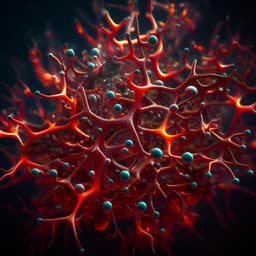
Engineering and Technology
Organic electrochemical neurons and synapses with ion mediated spiking
P. C. Harikesh, C. Yang, et al.
Discover the groundbreaking potential of organic electrochemical neurons (OECNs) that seamlessly integrate with a Venus Flytrap, showcasing bio-compatible spiking and plasticity. This revolutionary research, conducted by Padinhare Chalakkal Harikesh and colleagues, explores the future of artificial neuronal systems that can interact with various biological signaling systems.
~3 min • Beginner • English
Introduction
The study addresses the need for neuromorphic hardware that can seamlessly integrate with biological systems for applications such as brain–machine interfaces, prosthetics, and soft robotics. Conventional silicon-based neuromorphic circuits are rigid, require many components, consume relatively high power, and rely on mechanisms fundamentally different from ion-mediated biological signaling, hindering bio-integration. Organic semiconductors, by contrast, are solution-processable, soft, biocompatible, and capable of mixed ionic–electronic conduction, making them promising for bioelectronics and neuromorphic functions. Organic electrochemical transistors (OECTs), modulated by gate-driven ionic doping/de-doping, operate at low voltages (<1 V) with high transconductance and biocompatibility, and have been used in artificial synapses exhibiting both short- and long-term plasticity. Despite advances, artificial neurons that spike and can be readily bio-integrated have been limited, with prior organic implementations (e.g., OFET-based) requiring high voltages and mechanisms unlike biology. The authors propose organic electrochemical neurons (OECNs) built from all-printed complementary OECTs to realize ion-mediated spiking closely analogous to biological neurons, enabling low-voltage operation, tunable spiking via ionic environment, and facile bio-integration, including direct interfacing with a Venus flytrap.
Literature Review
Prior neuromorphic efforts include software-based algorithms and silicon hardware implementations for spiking neural networks and neural interfaces, but silicon suffers from rigidity, poor biocompatibility, and high complexity. Organic semiconductors have been used to realize artificial synapses and neuromorphic devices due to their structural kinship with biomolecules, softness, and mixed ionic–electronic transport. OECT-based synaptic devices have demonstrated short- and long-term plasticity, and printed OECT circuits have been scaled using benign processing. However, artificial neurons based on organic devices have been scarce; OFET-based neurons require high voltages (~5 V) and lack ion-mediated operation, limiting bio-integration. The authors build upon this literature by introducing OECT-based neurons that emulate ion-driven spiking and integrate with printed organic electrochemical synapses to demonstrate Hebbian learning and STDP.
Methodology
Device architecture: The OECN is based on printed complementary OECTs forming an Axon Hillock–like spiking circuit with an amplifier block and a positive feedback capacitor network. The p-type OECT uses a glycolated polybenzimidazobenzoic derivative (P(BZT-T)), and the n-type OECT uses the electron-transporting polymer BBL. OECT channels (W=2000 μm, L=200 μm) have thicknesses of ~20 nm (P(BZT-T)) and ~250 nm (BBL) to balance drive currents (~50 μA at VGS=0.6 V). Devices employ lateral Ag/AgCl gates and screen-printed carbon/silver electrodes on PET substrates. Fabrication combines screen printing (contacts, dielectrics, printed capacitors) and spray coating (semiconducting layers). An OECT inverter (p- and n-OECT pair) provides amplification; cascaded inverters yield gains up to ~200 V/V.
Spiking circuit: Input current I_in is integrated by membrane capacitor C_mem to raise V_mem; when V_mem crosses the amplifier transition voltage V_T (set by OECT thresholds), positive feedback via a capacitance divider (C_r and C_mem) triggers a rapid rise of V_out, generating an action potential. If current ceases before V_T, V_mem decays (failed initiation). The spiking dynamics are tuned by C_mem, intrinsic device capacitances, and electrolyte ionic concentration.
Printed monolithic neuron: External capacitors were replaced with printed lateral carbon-electrode capacitors (1 M NaCl electrolyte). The fully printed neuron exhibits similar behavior, with slightly lower spiking frequency. Intrinsic circuit capacitances can suffice for spiking even without discrete capacitors.
Synapses (OESCs): Printed on the same electrode architecture, synaptic channels are formed by in situ electropolymerization of a zwitterionic monomer (ETE-PC) to poly(ETE-PC). The presynaptic input is a gate voltage on Ag/AgCl; the postsynaptic output is the drain current (EPSC). Two operation modes: (i) short-term plasticity via ionic accumulation/depletion during gate-driven doping/undoping (seconds timescale), showing facilitation/depression and paired-pulse effects; (ii) long-term plasticity via stepwise electropolymerization (LTP) and overoxidation (LTD) pulses, providing multi-level conductance states with retention >1000 s.
Neuron–synapse integration: For STDP/Hebbian learning, presynaptic (source+gate tied) and postsynaptic (neuron V_mem) pulses are timed so that the maximum voltage difference (~0.6–0.68 V) for electropolymerization occurs only when spikes overlap, yielding symmetric Hebbian STDP. Pulse parameters (e.g., −0.8 V, 1 s) and delays (0–10 ms) control conductance change and resulting neuron firing modulation.
Characterization and simulation: Electrical measurements were performed using a Keithley 4200 SCS at ~20 °C and ~65% RH. 2D SPICE models (EMAG Technologies) for p- and n-type OECTs, based on measured DC/transient characteristics, simulated V_mem and V_out. Bio-integration with Venus flytrap used Ag/AgCl electrodes to deliver OECN output to the midrib/lobe with conductive gel, under controlled greenhouse conditions.
Power analysis: Dynamic power dominated by the amplifier block; at V_DD=0.6 V and I_dynamic up to 25 μA, maximum dynamic power is ~15 μW.
Key Findings
- First demonstration of organic electrochemical neurons (OECNs) with ion-mediated spiking using all-printed complementary OECTs; operation below 0.6 V.
- Frequency modulation via circuit parameters: With C_mem and input current tuning, frequency modulation exceeding ~450% is reported across 0.1–10 μA input range; example F–I behavior shows modulation from ~46 Hz up to ~270 Hz depending on capacitance and current, limited at high currents by inverter delay time.
- Ion concentration control: Increasing electrolyte (NaCl) concentration from 0.1 M to 1 M shifts amplifier transition voltage V_thr from ~0.5 V to ~0.2 V, increasing spiking frequency by ~25% and reducing spike FWHM.
- Capacitive effects: At low external capacitances, intrinsic device capacitances dominate, causing small (~5%) deviations between experiment and simulation. Spiking persists even without discrete capacitors due to intrinsic capacitances.
- Low power: Maximum dynamic power ~15 μW (V_DD=0.6 V, I_dynamic=25 μA), lower than OFET-based Axon-Hillock circuits (~40 μW). Scaling down channel dimensions is expected to further reduce power and FWHM while increasing response speed.
- Fully printed neuron: Monolithic integration with printed capacitors (1 M NaCl electrolyte) yields similar spiking, with a slightly lower frequency than discrete-capacitor versions.
- Bio-integration proof: Interfacing the OECN with a Venus flytrap demonstrates functional actuation: at 10 μA input, neuron output frequency ~100 mHz triggers trap closure; at 2 μA (frequency ~44 mHz), no closure occurs.
- Printed organic electrochemical synapses (OESCs): Show short-term facilitation/depression (paired-pulse metrics) via ionic accumulation; long-term potentiation/depression via electropolymerization (−0.6 V, 1 s write pulses) and overoxidation (−2 V, 1 s), with retention >1000 s.
- STDP and Hebbian learning: Symmetric Hebbian STDP achieved by overlapping pre- and postsynaptic spikes such that only coincident activity yields sufficient voltage for electropolymerization. Synchronous pre/post timing leads to significant conductance increase and higher neuron firing frequency (e.g., increase from ~22 mHz to ~30 mHz), whereas delays (5–10 ms) reduce or eliminate potentiation.
Discussion
The results demonstrate that OECT-based spiking neurons can emulate key features of biological neurons—threshold-driven spiking, positive feedback dynamics, and sensitivity to ionic environments—while operating at low voltages and power. The ion-mediated modulation of spiking (via electrolyte concentration and ionic doping/de-doping) directly parallels biological mechanisms, providing an avenue for intuitive coupling to living systems. Printing enables soft, flexible, large-area integration with high yield and straightforward matching of p/n device strengths through thickness control. The successful actuation of a Venus flytrap by tuning the OECN firing frequency underscores real-world bio-integration potential. Furthermore, integrating OECNs with printed OESCs yields a compact neuro-synaptic system that exhibits both short- and long-term plasticity and symmetric Hebbian STDP using far fewer elements than silicon implementations. This capability points to localized learning and adaptive behavior suited for event-based sensing, neuromorphic processing, and future implantable or wearable bioelectronic systems that can sense and respond to biochemical, physical, and chemical cues.
Conclusion
This work introduces the first all-printed OECT-based organic electrochemical neuron exhibiting ion-mediated spiking and demonstrates its seamless integration with printed organic electrochemical synapses. The OECN operates at <0.6 V with low power (~15 μW), supports wide frequency modulation via input current, capacitance, and electrolyte concentration, and can actuate biological systems (Venus flytrap) based on firing frequency. The printed OESCs provide both short- and long-term plasticity with retention >1000 s and enable symmetric Hebbian STDP when coupled to the neuron, achieving learning with minimal circuitry compared to silicon. These soft, flexible, and biocompatible neuromorphic elements offer a pathway to scalable, low-power, event-driven bioelectronic systems. Future work should focus on scaling device dimensions to increase spiking speeds and reduce energy, optimizing materials and geometries to tailor STDP timescales to biology, monolithic integration of multi-sensory inputs within neurons, and extending bio-integration to more complex plant and animal systems, potentially advancing implantable interfaces and distributed smart sensing for IoT.
Limitations
- Spiking frequency at high input currents is limited by the inverter delay time; achieving higher frequencies requires reducing device dimensions.
- At low external capacitances, intrinsic capacitances dominate, causing deviations between experiments and simulations (~5%).
- The fully printed neuron exhibits slightly lower spiking frequencies than configurations using discrete capacitors.
- Performance and spiking characteristics depend on electrolyte concentration (ionic environment), which may impose constraints in certain applications.
- Demonstrations are ex vivo (plant model); integration with in vivo animal systems is suggested but not shown.
Related Publications
Explore these studies to deepen your understanding of the subject.







